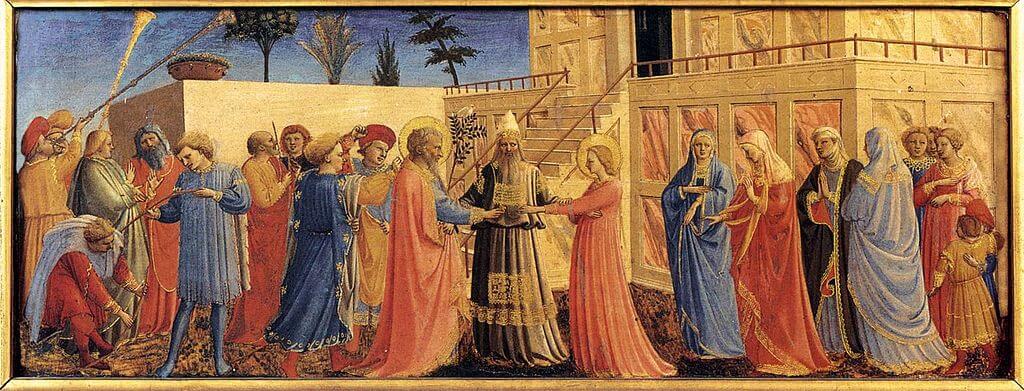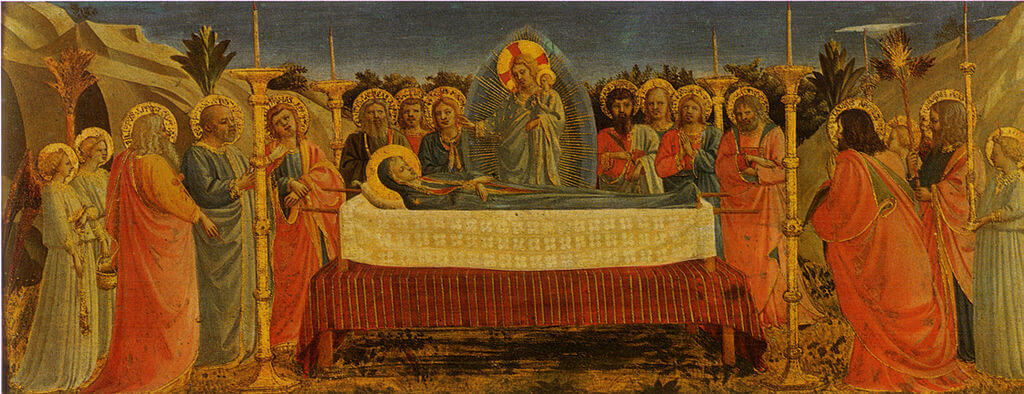|
Where? Room 7 of the Uffizi Museum
When? Between 1430 and 1435 Commissioned by? The nuns of the Santa Maria Nuova hospital in Florence. What do you see? Jesus and the Virgin Mary are on top of a series of small clouds, floating in the sky. This painting depicts paradise. Jesus is crowning the Virgin Mary as the Queen of Heaven. Mary has her arms crossed on her chest, slightly bends forward, and has a humble look on her face, while Jesus is decorating her golden crown with a jewel stone. Surrounding Jesus and Mary is a crowd of angels, blessed people, and saints. A choir of angels is playing music and dancing. You can see several angels scattered throughout the painting, recognizable by their wings, who are either playing music or are dancing. Three angels are dancing directly to the left of Mary, and you can see three others directly to the right of Jesus. On the top right and top left you can see some trumpets high up in the air and in the center foreground you can see two angels playing musical instruments. The angel in blue, turned with the back towards us, is playing a portable organ, and the angel to the left is playing a string instrument. Backstory: The painting probably formed an altarpiece together with two side panels, Wedding of the Virgin and Death of the Virgin, which are now both located in the Museum of San Marco in Florence. The painting contains both elements that are Gothic and elements that are typical for the Renaissance. For example, the golden background is gilded and is an element that was common in Gothic painting. The use of halos is also typical Gothic. The realistic way in which the people are depicted and the three-dimensionality are examples of the Renaissance style.
Symbolism: The gold crown signifies both power (by being an advocate of the king) and wealth (regarding God’s promises). Jesus and Mary are surrounded by bright rays of light, symbolizing their divinity.
What is the Coronation of the Virgin? Mary is crowned by her son Jesus as the Queen of Heaven. This occurs after Mary has been assumed into heaven. In ancient times it was common for the king’s mother to be crowned queen. This subject was quite popular in art since the 13th century. Why is Mary the Queen of Heaven? One of the many titles that Catholics have given to Mary is Queen of Heaven (Regina Caeli in Latin). Historically, in the Bible, the mother of the king had important powers in counseling the king and she was referred to as the Queen Mother. The reason that Mary is sometimes called the Queen of Heaven is that, according to the Catholic Church, Mary was assumed into heaven at the end of her earthly life. In Heaven, she is crowned as the queen (which is the coronation of the Virgin) as she is the mother of Jesus, who is the heavenly king of the universe. On October 11, 1954, Pope Pius XII decided that Catholics should celebrate the Queenship of Mary. Since 1969, the Queenship of Mary is a public holiday on August 22 in several countries, such as France and Spain. Another work of Fra Angelico on the Coronation of the Virgin? The current version originally belonged to the Church of Sant'Egidio in Florence and is shown in the Uffizi since 1825. However, Fra Angelico has painted another well-known version of the Coronation of the Virgin. This version is currently in the Louvre in Paris. In that painting, you can see that blue skies replace the more old-fashioned Gothic golden background.
Who is Fra Angelico? Fra Angelico was born around 1387 as Guido di Pietro and died in 1455. He was a Dominican friar and was widely respected because of his gentle personality. While he started in the monastery as an illustrator of manuscripts, he became known as a masterful painter of altarpieces.
Only after his death the name Fra Angelico was given to him. In his work he freely interpreted biblical stories, rather than accurately depicting the stories, to trigger spiritual responses of the people seeing those paintings and to stimulate prayer. Among his well-known works is The Adoration of the Magi, painted together with Filippo Lippi, in the National Gallery of Art.
Fun fact: Fra Angelico was known during his life as Il Beato Angelico or simply Il Beato (which means ‘the blessed’). He was a devout friar during his life and only painted religious works. He prayed before every painting, and once the painting was done he did not alter them anymore as he believed that God inspired his work. While he was already called ‘the blessed’ during his life, Pope John Paul II officially beatified him in 1982, praising his immaculate lifestyle and divine paintings.
Interested in a copy for yourself? Poster or canvas.
Written by Eelco Kappe
References:
0 Comments
Leave a Reply. |
Categories
All
|
- Home
- Blog
-
Museums
- Alte Pinakothek
- Art Institute of Chicago
- Baltimore Museum of Art
- Barber Institute of Fine Arts
- Bargello
- Barnes Foundation
- British Museum
- Church of Sant’Anastasia
- Cleveland Museum of Art
- Courtauld Institute of Art
- Detroit Institute of Arts
- Frans Hals Museum
- Galleria Borghese
- Gallerie dell'Accademia
- Getty Museum
- Guggenheim
- Hermitage Museum
- Kunsthistorisches Museum
- Kunstmuseum Basel
- Legion of Honor Museum
- Louvre
- Mauritshuis
- Metropolitan Museum of Art
- Musee d’Orsay
- Museum of Fine Arts in Boston
- Museum of Modern Art
- National Gallery in London
- National Gallery of Art
- National Museum in Poznań
- Norton Simon Museum
- Ny Carlsberg Glyptotek
- Palace of Versailles
- Palazzo Pitti
- Palazzo Vecchio
- Petit Palais
- Philadelphia Museum of Art
- Prado
- Pushkin Museum
- Ravenna Art Museum
- Rijksmuseum
- San Diego Museum of Art
- Santa Maria delle Grazie
- St. Peter's Basilica
- Städel Museum
- Statens Museum for Kunst
- Tate Britain
- Tate Modern
- Timken Museum of Art
- Uffizi
- Vatican Museums
- Wallace Collection
-
Artists
- Altdorfer
- Anguissola
- Berlin Painter
- Bosch
- Botticelli
- Boucher
- Bronzino
- Bruegel the Elder
- Brunelleschi
- Cabanel
- Caillebotte
- Canova
- Caravaggio
- Carpeaux
- Cezanne
- Cimabue
- David
- Degas
- Delacroix
- De Maria
- Donatello
- El Greco
- Fontana
- Fra Angelico
- Fragonard
- Gauguin
- Gentileschi
- Gericault
- Gonzalez-Torres
- Goya
- Hals
- Hogarth
- Hokusai
- Ingres
- Leonardo da Vinci
- Lippi, Filippo
- Longhi, Barbara
- Lorrain
- Makovsky
- Manet
- Massys
- Matisse
- Merian
- Michelangelo
- Mochi
- Modigliani
- Monet
- Panini
- Parmigianino
- Perugino
- Picasso
- Pisanello
- Raphael
- Rembrandt
- Renoir
- Reynolds
- Rivera
- Rodin
- Rubens
- Scultori
- Seurat
- Steen
- Tintoretto
- Titian
- Toulouse-Lautrec
- Turner
- Uccello
- Van der Weyden
- Van Dyck
- Van Eyck
- Van Gogh
- Van Hemessen
- Vasari
- Velazquez
- Vermeer
- Veronese
- Vigée Le Brun
-
Locations
- Books
- About Us





